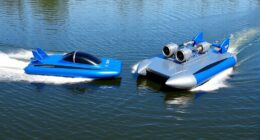To master takeoff stability in choppy conditions, stay alert to wind shifts and turbulence throughout your roll, keeping a firm grip on the controls. Make smooth, small adjustments to counter gusts and maintain your runway heading, while applying power steadily. Monitor outside cues like the horizon and turbulence indicators. Staying vigilant and responsive helps keep your aircraft stable during this critical phase. Continuing to practice these techniques will boost your confidence in handling even the roughest takeoffs.
Key Takeaways
- Conduct thorough pre-takeoff weather assessments to identify wind shear and turbulence risks.
- Maintain firm grip on controls and make small, smooth adjustments during the takeoff roll.
- Stay alert for gusts, wind shifts, and horizon cues to respond promptly to changing conditions.
- Use consistent power application and avoid abrupt control inputs to ensure stable acceleration.
- Monitor the environment during initial climb, adjusting control inputs as needed to counteract turbulence effects.

Achieving stable takeoffs is essential for safe and efficient flying, and mastering this skill requires understanding the key factors that influence your aircraft’s behavior during the critical phase. When conditions are choppy, unpredictable elements like wind shear can drastically impact your aircraft’s performance, making it vital to recognize and respond to these challenges promptly. Wind shear, a sudden change in wind speed or direction, can cause your aircraft to pitch unexpectedly or lose lift just as you’re about to lift off. To handle this effectively, you need to be proactive and use specific pilot techniques that help maintain control and ensure a smooth departure.
One of the most important pilot techniques involves thorough pre-takeoff planning. Before even moving onto the runway, check the latest weather reports for signs of wind shear or turbulent conditions. If wind shear is forecasted or suspected, adjust your takeoff strategy accordingly. This might mean delaying the departure or choosing a different runway or wind conditions that are more favorable. During the takeoff roll, remain alert, especially if you notice sudden gusts or shifts in wind direction, which could indicate wind shear. Keep your hands firmly on the yoke or stick, and be prepared to make small, controlled adjustments to maintain the aircraft’s nose attitude and heading.
Thorough pre-takeoff planning and weather checks are vital for safe, stable departures.
As you accelerate down the runway, focus on maintaining a consistent, smooth application of power. Abrupt throttle movements can exacerbate the effects of wind shear and destabilize your aircraft. During this phase, it’s crucial to keep your eyes outside, scanning the wind indicators and horizon for signs of turbulence or sudden shifts. When you feel or see evidence of wind shear, respond quickly with appropriate pilot techniques—such as gently adding power if the aircraft is losing lift or adjusting pitch to prevent a stall. Avoid overreacting; smooth, deliberate inputs are key to maintaining stability. Additionally, understanding how juice cleansing effects can influence overall health and alertness may help pilots stay vigilant during demanding flight operations.
Once you lift off, continue to monitor the environment closely. If wind shear was a factor during the initial climb, be prepared for further turbulence or sudden changes in airflow. Use your training and experience to make subtle control inputs, keeping the aircraft on its intended climb path. Remember, your ability to adapt quickly and apply sound pilot techniques during these choppy conditions is what determines a safe and stable takeoff. Mastering these skills takes practice, but understanding the influence of wind shear and maintaining proper control inputs will give you the confidence needed to handle even the most turbulent takeoff conditions safely.
Frequently Asked Questions
How Do Wind Shifts Affect Takeoff Stability?
Wind shifts can greatly impact your takeoff stability by causing sudden changes in wind direction and speed. These shifts create wind shear and turbulence effects that make controlling your aircraft more challenging, especially during critical stages like rotation. You need to stay alert and adjust your controls promptly to counteract these disturbances. Recognizing and responding to wind shear and turbulence effects ensures a safer, more stable takeoff even when conditions are unpredictable.
What Equipment Can Improve Stability in Choppy Waters?
You might think equipment won’t make much difference, but improved hulls and stabilizing fins can markedly boost your stability in choppy waters. Improved hulls cut through waves more smoothly, reducing pitching and yawing, while stabilizing fins help maintain course and balance during rough takeoffs. By investing in these tools, you’ll find it easier to stay steady, even in unpredictable conditions, giving you more confidence and control.
How Does Weight Distribution Influence Takeoff in Rough Conditions?
Your weight distribution greatly impacts takeoff in rough waters. By keeping your center of gravity low and centered, you improve stability. Proper ballast management helps you adjust weight to counteract waves and chop, preventing nose dives or instability. Shifting weight slightly aft or forward as needed can maintain smooth acceleration. Focus on balanced weight placement and effective ballast use to stay steady and confident during the takeoff, even in challenging conditions.
Are There Specific Techniques for Handling Sudden Waves During Takeoff?
When handling sudden waves during takeoff, focus on wave timing and throttle modulation. Anticipate the waves and plan your approach, adjusting your throttle smoothly to maintain control. Keep your eyes on the water to spot changes early, and don’t jerk the throttle or steer abruptly. By staying calm and responsive, you can navigate unpredictable waves more effectively, ensuring a safer, more stable takeoff even in rough conditions.
How Can Pilots Anticipate and React to Unpredictable Choppy Conditions?
Imagine you’re steering choppy waters with the precision of a ship captain in 1800s storm. To anticipate and react to unpredictable conditions, rely on advanced weather forecasting tools and stay updated on real-time data. Regular pilot training simulations prepare you for sudden waves and turbulence, enhancing your instinct and confidence. Always keep a vigilant eye on the horizon, ready to adapt quickly and maintain control during turbulent takeoff moments.
Conclusion
Now that you know how to keep your takeoff stable in choppy conditions, you’re ready to tackle rough waters head-on. Remember, it’s all about staying calm and adjusting your approach as needed—don’t let the waves throw you off course. With practice, you’ll find that smooth sailing becomes the norm rather than the exception. Keep these tips in mind, and you’ll be able to handle any rough patch with confidence—after all, fortune favors the brave.










